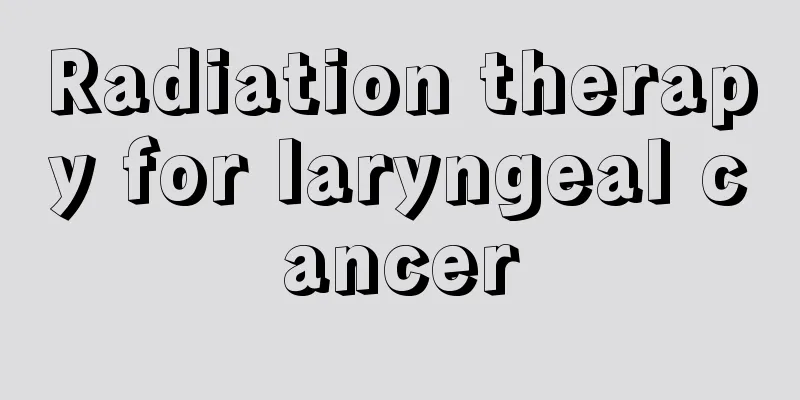Radiation therapy for laryngeal cancer

|
Radiotherapy is one of the important means of treating laryngeal cancer. Radiotherapy can better preserve the function of the larynx, but it is not as good as surgical resection in terms of long-term efficacy. Domestic and foreign data show that for glottic cancer lesions alone, the effect of radiotherapy is equivalent to that of surgical resection, and the 5-year survival rate can reach 80%~100%. The radiotherapy effect of other types and stages of laryngeal cancer is not as good as surgical resection. The more advanced the lesion, the greater the gap between the effects of radiotherapy and surgery. Therefore, a combination of surgery and radiotherapy should be adopted for mid- and late-stage laryngeal cancer. 1. Indications for radiotherapy ① For T1 lesions, especially T1 lesions of glottic cancer, radiotherapy may be the first choice. ② For malignant lymphoma or undifferentiated cancer, which is sensitive to radiotherapy, radiotherapy alone may be performed. ② For stage II, III, and IV cases, planned preoperative radiotherapy or adjuvant postoperative radiotherapy may be performed. ④ For patients with incomplete surgical resection. ⑤ For recurrent cases or advanced cases, palliative radiotherapy may be performed for patients who cannot undergo surgery. 2. Precautions before radiotherapy (1) Make a clear diagnosis and confirm the necessary imaging data, such as X-rays, CT, MRI, etc.: understand the scope of the lesion, determine the stage, and formulate a treatment plan. (2) If there are infectious lesions within the tumor and the irradiation range, inflammation should be controlled before radiotherapy. (3) Advise the patient to use the throat appropriately, talk less, quit smoking and drinking, keep the oropharynx clean, improve the general condition, and correct anemia; (4) Patients with breathing difficulties should undergo tracheotomy before radiotherapy to avoid acute laryngeal edema, suffocation and other critical conditions during radiotherapy. (5) After tracheotomy or total laryngectomy, when a tracheal tube must be worn for treatment, it must be replaced with a plastic tube or a silicone tube to avoid radiation exposure to the metal tube, resulting in secondary radiation and local damage. When extubation is allowed, the metal tube can also be removed during each treatment. (6) After total or subtotal laryngectomy, radiotherapy should be started 4 weeks after surgery to avoid premature treatment that affects tissue healing and causes infection, necrosis, pharyngeal fistula, etc. (7) When designing the irradiation field and formulating the radiotherapy plan, attention should be paid to controlling the dose to the cervical spinal cord within DT40Gy to prevent radiation spinal cord injury. |
<<: Diagnosis of laryngeal cancer
>>: The relationship between esophageal cancer and lifestyle habits
Recommend
Quick tips for getting rid of acne_ Tips for getting rid of acne immediately
Many people want to use a method to achieve the e...
Does beef cause heaty food? Beef lovers must know this!
Beef is a kind of meat that people often use in t...
What are the diagnostic methods for lung cancer? Lung cancer has these three high-risk factors
Lung cancer is one of the most common malignant t...
What are the causes of bladder cancer
In recent years, bladder cancer has become one of...
What to do if pancreatic cancer causes ascites
From the beginning of the disease, adverse sympto...
A 27-year-old Fujian woman was diagnosed with cervical cancer. She has three life misconceptions that are thought-provoking
The story of Xiao Lin, a 27-year-old woman in Fuj...
What is whale oil used for
Whale oil is taken from the body of a whale. We k...
What are the hazards of carbon powder to human body
I have always thought that toner is made of carbo...
How to deal with burn blisters on your hands_How to deal with burn blisters on your fingers
Burns are a very common injury. After a burn, dif...
How to quickly lower alanine aminotransferase
Excessively high alanine aminotransferase levels ...
What are the effects and functions of chitin
Chitin is a common medicine in nature. It can eff...
Why do gums turn black
Everyone wants to have a set of white and clean t...
How long does it take for the scar from the rove beetle to disappear
How long does it take for rove beetle scars to di...
Cupping principles and effects
I believe everyone must have seen cupping, a trea...
How much does biological therapy for ovarian cancer cost
I believe everyone knows that ovarian cancer has ...









